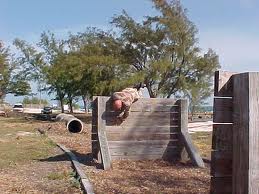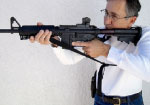The seriousness of the emergencies handled by a tactical unit dictates the necessity of an officer/deputy that is mentally and physically fit. A grenadier must be as fit as any tactical officer and be able to handle the psychological effects of tear gas. The physical fitness of the grenadier/tactical officer is important. It should be a factor in the selection process of the officer and it should be continually monitored.
A tactical team member must be able to physically achieve difficult positions in all environments. He or she must achieve these positions without suffering from fatigue. They should be able operate for extended periods of time wearing their respirators. If he or she suffers fatigue it will hinder their ability to make judgments and fire with accuracy a projectile rifle and/or a firearm. A tactical team member wearing a respirator must be able to move quickly with agility while in fire zones or while rescuing downed teammates. He must be able to overcome persons of normal strength and those with hyper strength brought about by chemical ingestion.
positions in all environments. He or she must achieve these positions without suffering from fatigue. They should be able operate for extended periods of time wearing their respirators. If he or she suffers fatigue it will hinder their ability to make judgments and fire with accuracy a projectile rifle and/or a firearm. A tactical team member wearing a respirator must be able to move quickly with agility while in fire zones or while rescuing downed teammates. He must be able to overcome persons of normal strength and those with hyper strength brought about by chemical ingestion.
All of these traits can be obtained if the grenadier/tactical team member has proven strength, stamina and agility. It is important to recognize these attributes prior to assigning an officer to a tactical unit. Many different evaluation methods are used around the world. These methods range from confidence courses to cross country running. One method many agencies employ is agility/obstacle courses. A properly constructed obstacle course can evaluate a person in those areas that are most relevant to a tactical operation.
An obstacle course is a form of strength and agility exam. This is a method adopted by many agencies. A physical agility standard for the tactical officer/deputy is one that should be present in every agency. A problem that arises with these types of tests as a selection criterion is that women perform less well than men. This can lead to charge of discrimination. There is little basis for argument that, on the average, women possess less physical strength than men. In overall terms, a common estimate for women's strength is approximately two-thirds of the average man's, although the proportion varies depending upon which muscle group is being considered and the range is considerable among women and men. The differences between sexes in endurance, in contrast, are less marked, and evidence indicates female superiority in this area. 1
To the extent that physical strength demands of this job are considerable, and to the extent that the average woman has less strength than the average man, one would think that women would be less suited for a tactical position than would men. At the same time it is possible to overestimate the amount of physical demands involved in tactical operations. Because these tests discriminate against women EEO guidelines must be considered in the development of your test. What is required to make these tests legal is the removal of artificial, arbitrary and unnecessary barriers to selection when the barriers operate invidiously to discriminate on the basis of racial or other impermissible classifications. 2
In the 1980's San Diego Sheriff’s Special Enforcement Detail considered these problems and instituted a strength/agility obstacle course as a selection criterion. It is in use today as an effective testing and training tool. If you are using a physical agility test or considering one you must document its creation. Each and every part of the SED O-course was documented for its job relatedness and construction standards. Each  obstacle on the course was one that had been encountered at a tactical incident by the course designer (That designer was then Lieutenant Scott McClintock). Each obstacle was constructed to meet county building codes. The entire course was examined by an exercise cardiologist and an industrial physician. Both agreed that the course met its intended goals and was not physically demanding to the point of exclusion for the sake of discrimination. They felt the course was job related and a deputy assigned to SED should be able to complete the course in a reasonable amount of time.
obstacle on the course was one that had been encountered at a tactical incident by the course designer (That designer was then Lieutenant Scott McClintock). Each obstacle was constructed to meet county building codes. The entire course was examined by an exercise cardiologist and an industrial physician. Both agreed that the course met its intended goals and was not physically demanding to the point of exclusion for the sake of discrimination. They felt the course was job related and a deputy assigned to SED should be able to complete the course in a reasonable amount of time.
After running almost one hundred test subjects through the course, the times of 4:30 to qualify for selection and 4:00 to re-qualify once in the detail were established. There are two important factors to consider when establishing a pass/fail qualifying time.
First, it should be kept in mind that the course tests a rounded total of a deputy’s; cardiovascular fitness, agility, and body strength. Secondly, the time should be medically established so it will not lead to unnecessary injuries.
The SED course is one quarter of a mile around and close to that distance up and down. Their course is constructed with the start finish lines next to each other. This helps in the ease of timing runners. All stations of the course can be observed from the start finish line. There are nineteen different stations or obstacles on the course and are described in the following text. They are not in the order encountered on the course.
1. 100 yard preliminary run
This run simulates a SWAT deputy deploying from the command post toward his position. Since the entire course is timed, it is necessary for him to adjust his own pace to minimize his fatigue when he gets to the obstacles. This run covers four types of terrain encountered in San Diego County. It has sand, flat hardpan, an asphalt roadway, railroad bed, cultivated grass, rocky stream bed and a bushy hillside.
2. Slalom
This station is a series of offset barricades which require the deputy to make quick, sharp turns while running. This simulates a foot pursuit or sprint for cover through areas requiring agile footwork, such as parking lots, crowds of people or orchards.
3. Cinder block wall (5 feet)
All of the walls and fences in this course are types commonly encountered in our county. The deputy must climb over the top of each wall or fence section to simulate a SWAT team member overcoming a wall or fence to get to his assigned tactical position.
4. Chain link garden fence (3 feet)
This fence is low enough to be hurdled or vaulted without having to climb over it.
5. Crawl simulator
This obstacle requires the deputy to progressively perform a low crawl, high crawl and a duck walk under a chain link ceiling. When SWAT deputies are moving behind cover of different heights their posture must remain below restrictive levels.
6. Vertical wood fence (5 feet)
 For durability this station is constructed with vertical paneling on both sides of the supports.
For durability this station is constructed with vertical paneling on both sides of the supports.
7. Large window
This obstacle simulates a building entry through a living room or bedroom window. This window is relatively large and low to the ground.
8. Victim Drag
The runner drags a steel weight twenty feet in simulation of the rescue of a downed person from a place of danger. The victim is built of welded steel pipe for durability and weighs approximately the same as an average adult male. (160 pounds)
9. Grape stake fence (6 feet)
This station offers a different texture and shape of fence, which requires slightly different skills to overcome.
10. Barbed wire fence (4 feet)
This four strand fence is representative of rural obstacles found in our county. Runners must step through the two middle strands as it is impossible to step over the top of it. We use plain wire, no barbs, to prevent the tearing of uniforms.
county. Runners must step through the two middle strands as it is impossible to step over the top of it. We use plain wire, no barbs, to prevent the tearing of uniforms.
11. Common chain link fence (5 feet)
This section is constructed with no prongs towards the top. This again is to prevent injury and the tearing of uniforms. All supports are in the rear so that the deputy must scale the chain link and not the supports.
12. Culvert or drain pipe
In rural areas of the county culverts and drain pipes similar to this one are commonly found under driveways and side streets. It is laid on top of the existing grade to prevent the flooding of the pipe during rainy seasons.
13. High chain link fence (11 feet)
Many schools, institutions, auto repair businesses, and recreational sites use extended height chain link fence for security. The braces are on the back side of the fence causing the deputies to climb the weave. It also has a fire hose top. This was added after deputies caught their shoelaces on the top and fell to the ground. It doesn't’t hamper the climb, but does add safety to the obstacle.
14. High window
This station simulates and entry into a high window such as a bathroom window. It requires more agility because of its small size and height. On the back side of the obstacle there is a platform simulating a counter and a sink.
15. Brick or block wall (4 feet)
This station simply simulates a different type constructed wall. It is double thickness for stability because of the number of people that traverse it.
16. Sub-flooring crawl space
 Building searches for suspects have not been limited to just rooms. If a building has sub-flooring it also must be cleared. Although rare it has been done. This obstacle is built from the dimensions of an actual house built in the 1950’s.
Building searches for suspects have not been limited to just rooms. If a building has sub-flooring it also must be cleared. Although rare it has been done. This obstacle is built from the dimensions of an actual house built in the 1950’s.
17. Attic entry Roof dismounts and balance wall
The three final maneuvers are accomplished on one structure. It consists of a simulated attic entry. The height of the crawl space is six feet from the ground. This simulates using a chair or something else to get a boost. The runner then must pull himself to a platform where a pitched roof is attached. The runner then dismounts the platform to a balance beam. He must walk across the top of this beam for a distance of 20 feet without falling. This obstacle simulates the ability to pull oneself up and balance while tired.
There is some legal precedent set for these type physical\agility tests. In Blake vs. City of Los Angeles the court stated there is no magic in any validating procedure, and the defendants need only to supply competent and relevant evidence on the issue.3 In Harless vs. Duck (1977) a physical agility test had an adverse impact on women. The test was defended on the basis that the obstacle course approximated tasks performed on the job by patrolman, and that the requirement tended to measure strength and coordination, characteristics observed to be important in successful performance of the job of patrolman.4 Although a look at your own selection criteria might show a disparate impact on women, if you treat all applicants equally, and your selection criteria is job related, you will probably have a valid test. The true validness of your process will not be known until it is tested in court.
1. John Bernardin, ed., Women in the Work Force (New York: Praeger Special Studies, 1982), P.34 back
2. Richard Peres, Dealing with Employment Discrimination (New York: McGraw—Hill Book Co, 1978) p.53. back
3. Richard Arvey, Fairness in Selecting Employees (Mass: Addison-Wesley Publishing Company, 1979), P.81 back
4. Ibid. , p. 81 back





